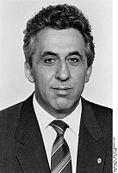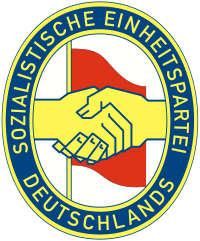- Leadership of East Germany
-
Leadership of East Germany Former socialist state 
State Coat of arms 
Last leader:
Egon Krenz,
last Communist ruler of East GermanyFirst leader(s) Wilhelm Pieck
(first president)
Otto Grotewohl
(first prime minister)Last leader(s) Egon Krenz
(last Communist ruler)Suceeding state leader(s) Sabine Bergmann-Pohl
(last head of state)
Lothar de Maizière
(last prime minister)Communist rule started 7 October 1949 Communist rule ended 6 December 1989/
18 March 1990
(Communist dictatorship ended)State ended 3 October 1990
(German reunification)The political leadership of East Germany was in the hands of several offices.
Prior the proclamation of an East German state, the Soviets established in 1948 the German Economic Commission (DWK) as a de facto government in their occupation zone. Its chairman was Heinrich Rau.
On 7 Oct 1949 an East German state, called the German Democratic Republic (GDR), was proclaimed and took the governmental functions over from the DWK. (Largely with the same function owners.)
For most of its existence (until autumn of 1989), the most important position in the GDR was that of the General Secretary of the Socialist Unity Party (SED). The Communist party and its leader held ultimate power and authority over state and government.
The formal head of state originally was the President of the German Democratic Republic. After the death of incumbent Wilhelm Pieck in 1960, the office was replaced by a collective head of state, the State Council. The position of chairman was commonly held by the party leader.
Government was headed by the Council of Ministers and its chairman, sometimes colloquially called Prime Minister.
Other important institutions included the People's Chamber, whose sessions were chaired by a President of the People's Chamber, and, since 1960, the National Defense Council, which held supreme command of the GDR's armed forces and had unlimited authority over the State in time of war. The Council was composed exclusively of members of the SED's Central Committee and Politburo, with the party leader serving as Chairman of the National Defense Council.
The political landscape was completely changed by the peaceful revolution late in 1989, which saw the Socialist Unity Party of Germany having to relinquish its monopoly on political power and the National Defense Council and the State Council being abolished. The remaining institutions were the People's Chamber, whose President by default became head of state for the remainder of the GDR's existence, and the Council of Ministers, both now based on the country's first and democratic elections in March 1990. The GDR joined the Federal Republic of Germany on 3 October 1990
Contents
Leaders of the Socialist Unity Party of Germany (SED)
# Picture Name Took office Left office Party Joint Chairmen of the Socialist Unity Party
Vorsitzende der Sozialistischen Einheitspartei Deutschlands
Wilhelm Pieck 22 April 1946 25 July 1950 Socialist Unity Party of Germany 
Otto Grotewohl Socialist Unity Party of Germany General Secretary of the Central Committee
(after 1953 titled First Secretary of the Central Committee)
Generalsekretär/Erster Sekretär des Zentralkommitees1 
Walter Ulbricht 25 July 1950 3 May 1971 Socialist Unity Party of Germany (Honorary) Chairmen of the Central Committee
Vorsitzender des Zentralkommitees
Walter Ulbricht 3 May 1971 1 August 1973 Socialist Unity Party of Germany General Secretary of the Central Committee
(until 1976 titled First Secretary of the Central Committee)
Generalsekretär/Erster Sekretär des Zentralkommitees2 
Erich Honecker 3 May 1971 18 October 1989 Socialist Unity Party of Germany 3 
Egon Krenz 18 October 1989 3 December 1989 Socialist Unity Party of Germany Late in 1989, the SED transformed from a leninist cadre party into a democratically structured party, renaming itself first to Socialist Unity Party — Party of Democratic Socialism and later in the same year, to Party of Democratic Socialism in the process, and relinquished its monopoly on political power. Hence, the party's subsequent leaders were no more leaders of East Germany than the leaders of other parties.
Heads of state
# Picture Name Took office Left office Party President
Staatspräsident
Johannes Dieckmann
Acting President7 October 1949 11 October 1949 Liberal Democratic Party of Germany 1 
Wilhelm Pieck 11 October 1949 7 September 1960 Socialist Unity Party of Germany 
Johannes Dieckmann
Acting President7 September 1960 12 September 1960 Liberal Democratic Party of Germany Chairman of the State Council
Vorsitzender des Staatsrats1 
Walter Ulbricht 12 September 1960 1 August 1973 Socialist Unity Party of Germany 
Friedrich Ebert junior
Acting Chairman1 August 1973 3 October 1973 Socialist Unity Party of Germany 2 
Willi Stoph 3 October 1973 29 October 1976 Socialist Unity Party of Germany 3 
Erich Honecker 29 October 1976 18 October 1989 Socialist Unity Party of Germany 4 
Egon Krenz 18 October 1989 6 December 1989 Socialist Unity Party of Germany 5 
Manfred Gerlach 6 December 1989 5 April 1990 Liberal Democratic Party of Germany President of the People's Chamber of the GDR
Präsident der Volkskammer1 
Sabine Bergmann-Pohl 5 April 1990 2 October 1990 Christian Democratic Union Heads of government
# Picture Name Took office Left office Party Chairman of the Council of Ministers
Vorsitzender des Ministerrats1 
Otto Grotewohl 12 October 1949 21 September 1964 Socialist Unity Party of Germany 2 
Willi Stoph 21 September 1964 3 October 1973 Socialist Unity Party of Germany 3 
Horst Sindermann 3 October 1973 29 October 1976 Socialist Unity Party of Germany 4 
Willi Stoph 29 October 1976 13 November 1989 Socialist Unity Party of Germany 5 
Hans Modrow 13 November 1989 12 April 1990 Socialist Unity Party of Germany 6 
Lothar de Maizière 12 April 1990 2 October 1990 Christian Democratic Union Heads of parliament
# Picture Name Took office Left office Party President of the People's Chamber
Präsident der Volkskammer1 
Johannes Dieckmann 7 October 1949 22 February 1969 Liberal Democratic Party of Germany 2 
Gerald Götting 12 May 1969 29 October 1976 Christian Democratic Union 3 
Horst Sindermann 29 October 1976 13 November 1989 Socialist Unity Party of Germany 4 
Günther Maleuda 13 November 1989 5 April 1990 Democratic Farmers' Party of Germany 5 
Sabine Bergmann-Pohl 5 April 1990 2 October 1990 Christian Democratic Union Heads of the military
# Picture Name Took office Left office Party Chairman of the National Defense Council
Vorsitzender des Nationalen Verteidigungsrates1 
Walter Ulbricht 10 February 1960 3 May 1971 Socialist Unity Party of Germany 2 
Erich Honecker 3 May 1971 18 October 1989 Socialist Unity Party of Germany 3 
Egon Krenz 18 October 1989 6 December 1989 Socialist Unity Party of Germany See also
- List of German monarchs
- President of Germany
- President of Germany (Weimar Republic)
- List of German presidents
- Chancellor of Germany
- List of Chancellors of Germany
External links
Categories:- Leaders of East Germany
- Politics of East Germany
- Lists of political office-holders in Germany
- East Germany-related lists
Wikimedia Foundation. 2010.

